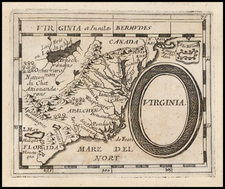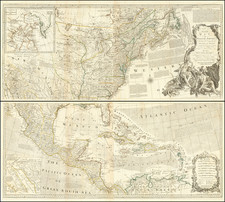Finely executed manuscript survey, showing a portion of what was then Washington County, Georgia, involving one of the principal characters of the Pine Barrens Fraud and a land surveyor who was likely part of the corrupt land grant process which plagued Georgia in the 1780s.
The map shows the area just to the northeast of Sands Pond, where Little Bull Creek, Bull Creek and the Canouchee River intersect, at the eastern border of Evans County, between Claxton and Pembroke, Georgia.
The map was drawn by Washington County, Georgia Deputy Surveyor, Solomon Pendleton in April 1786, in connection with a grant of land dated April 12, 1786, at the confluence of the Canouchee River and "Big Bull Creek". The map shows several tracts of land belonging to Patrick Crookshank, along with the lands owned by William Thorn.
Most notably, there are 3 contiguous 1000 acre tracts shown as the property of Patrick Crookshank, one of the principal characters involved in the Pine Barrens Fraud.
Until 1803, the State of Georgia distributed land based on a "headright" system. Each head of family had the "right" to 200 acres of land for himself and 50 acres of land for each member of his family, up to 1000 acres. After the Revolutionary War, a number of governors signed land grants of significantly greater amounts than the law allowed. These grants, most of which were signed by Governors George Walton, George Mathews, George Handley, Edward Telfair, and Jared Irwin, served to fuel land speculation that would briefly put Georgia in the national spotlight.
The Pine Barrens Fraud or Speculation, was the result of attempts to manipulate the grant system for individual advantage by receiving large grants. The scheme effected many early Georgia counties, but Montgomery County was most effected. Individuals applied for either large tracts of more than 1,000 acres, or multiple grants for 1,000 acres. As noted in Georgia Land Surveying History and Law at pages 87-88:
These practices continued under the . . . administration of Governor George Handley. In 1788, in an attempt to stem the rising tide of malfeasance, Handly issued an executive order directing the surveyor general not to pass grants on warrants in excess of one thousand acres. The land courts were notified of this order, but a simple expedient was quickly devised to circumvent it. One merely had a series of warrants made out, each for a thousand acres or less; had the county surveyor lay the tracts off into separate (even contiguous) blocks of a thousand acres or less; and then acquired a separate grant for each tract.
For five years after Governor Handley's order, no significant action was taken to check the various artifices and more or less corrupt methods that were often employed to secure warrants. . . . Statehouse officers received fees in direct proportion to the number and size of grants, probably abetting an official attidue toward sanctioning the illegal grants.
The stage was now set for organized corruption on a grand scale. In the early 1790s a company of unprincipled land speculators, who had previously been operating in South Carolina, came to Georgia and began collaborating with some of the state's citizens. Many of Georgia's collaborators sat on justice courts or were county surveyors and were therefore familiar with the various ways to manipulate the granting process. Included in the nefarious combination were . . . Patrick Crookshank.
The surveyor, Solomon Pendleton (1751-1787), was born in New York and served during the Revolutionary War, primarily as a 1st Lieutenant. In October 1777, he was caputred by the British at Fort Montgomery and later paroled at New Utrecht in 1778, before finally gaining his release on February 8, 1781. He traveled first to Pennsylavnia and then on to Georgia, where "he became a Surveyor of Government lands and received large grants for his service. . . . Solomon became possessed of considerable property in Chatham and Effingham Counties . . . during his next few years. . . " Brian Pendleton and His Descendants, 1599-1910: . . . Volume 1, p.64.
Deputy Surveyor of Washington County, Georgia. Active 1785.









![[French Colonization in Florida and the Southeast] La Floride Francoise Dressee sur La Relation des Voiages que Ribaut, Laudonier, et Gourgues y ont faits in 1562, 1564 et 1567 . . .](https://storage.googleapis.com/raremaps/img/small/91072.jpg)
![(Civil War) Fredericksburg … [with] Map… of the Sioux Expedition [with] Map of the Fight of the 14th A.C. Buzzard Roost, GA [and ] Big Mound [and] Dead Buffalo Lake [and] Dry Fort Creek](https://storage.googleapis.com/raremaps/img/small/97072.jpg)

![A New Map of Virginia [Chesapeake]](https://storage.googleapis.com/raremaps/img/small/43053.jpg)
![[ Florida Indians - Destroying the Enemy's Towns By Night ] Hostium oppida noctu incendendi ratio. XXXI.er absagen](https://storage.googleapis.com/raremaps/img/small/97385.jpg)
